React Native Application Development: Tips, Tricks and Techniques
Regarding cross-platform app development, React Native is the first choice amongst developers. Considering all the benefits this Facebook-backed robust framework offers developers, it is an obvious choice.
As per the survey by Stack Overflow, 2023, 9.5% of professional developers prefer React Native.
Furthermore, the study from Grand View Research reveals that they expect a compound annual growth rate of 13.4% from 2022 to 2023.

React Native is here to stay and for a long time. As Facebook owns it, you can expect continuous evolutions and new versions. It makes it a perfect choice for high-end mobile app development.
Let’s check out what React Native is before discussing React Native tips, tricks, and techniques to build React Native applications.
What is React Native?
React Native is a Facebook-owned JavaScript framework used to develop advanced mobile apps for Android and iOS. It is one of the most promising cross-platform frameworks that offers developers a wide array of benefits. The framework makes the job of developers smooth sailing.
It was made open-source in 2015, and since then, developers have preferred using it for cross-platform app development. It has a declarative UI like React, and you can write the app as a composition of various reusable components. During the process, these reusable components are rendered as native UI elements that perfectly match the look and feel of a particular platform.
Developers also use JavaScript for native components like camera, location, push notifications, etc. Not just that, the framework also allows developers to use native code like Objective-C and Kotlin for iOS and Android. They can write custom modules or components that can easily interact with JavaScript.
With React Native, you can achieve the best of native and cross-platform app development. You can have apps that look like native apps with the efficiency and performance of cross-platform apps.
Pros and Cons of React Native:
Let’s check out some of the benefits and limitations of React Native. It would be better to understand them before you choose React Native for your project.
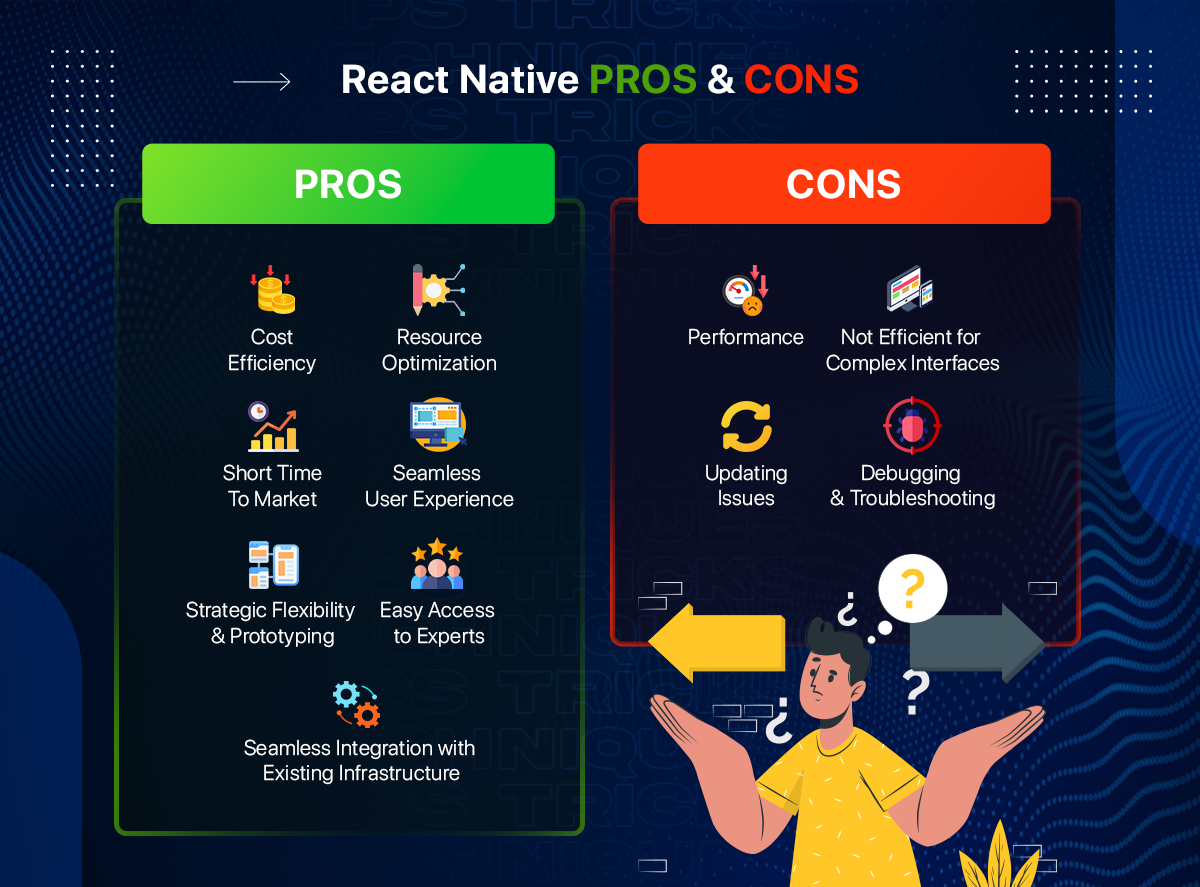
Advantages of React Native
#1. Cost Efficiency
With React Native, you can develop cross-platform apps with a single codebase for Android and iOS platforms. Hence, you can reduce your costs to a great extent.
#2. Resource Optimization
Also, when you can develop two separate apps for Android and iOS, you don’t have to hire two separate development teams for both platforms. You can optimize your resources and budgets.
#3. Short-Time-To-Market
With React Native, you can easily develop a Minimum Viable Product quickly and effortlessly. You can use React Native features like code reusability and development speed. With these features, you can easily create an MVP faster to receive user feedback for better decisions.
#4. Seamless User Experience
The best thing about React Native apps is that they look like native apps for Android and iOS platforms. Developers also don’t have to optimize mobile apps for platforms. These apps offer a consistent and seamless user experience across devices.
#5. Strategic Flexibility and Prototyping
React Native offers excellent flexibility and versatility. This trait makes React Native one of the most preferred choices among corporate ventures. It offers rapid iteration and experimentation to launch the app in the limited market to get end-user feedback. You can make data-driven decisions based on prototyping.
#6. Easy Access to Experts
React Native has a robust ecosystem and strong community support. It helps businesses to get easy access to experts for troubleshooting and other development issues.
#7. Seamless Integration with Existing Infrastructure
When you work for corporations with existing infrastructure and systems, you must integrate new apps or systems with the existing systems. React Native is compatible with third-party libraries and plugins to ensure smooth integration. Apps can perform optimally with the existing infrastructure as well.
Limitations of React Native
#1. Performance
Though React Native apps offer a native-like experience, they are not exactly like native apps. It is a limitation to mention with. The React Native framework is taking all steps necessary to overcome this limitation. For example, Hermes, a new JS engine, can help React native developers build apps that run even faster on older Android devices.
#2. Not Efficient for Complex Interfaces
If your app architecture involves complex designs and advanced interactions, go for native app development. When you want to handle complex animations and computational tasks, React Native might not perform as well as native.
#3. Updating Issues
Facebook owns React Native and they release newer versions regularly. It might be challenging for developers to update the app with new versions of React Native.
#4. Debugging and Troubleshooting
Another limitation is debugging and troubleshooting, which is challenging in React Native apps compared to other native apps. The thing is, React Native has JavaScript and native code that make issue diagnosis and resolution complex and challenging. it also might lead to performance issues. Developers must be well-versed with comprehensive testing and debugging tools to mitigate challenges and improve overall performance.
Tips for Using React Native Apps
It is time to discuss React Native performance tips, tricks, and techniques to develop world-class cross-platform apps. We will start with some useful tips first.
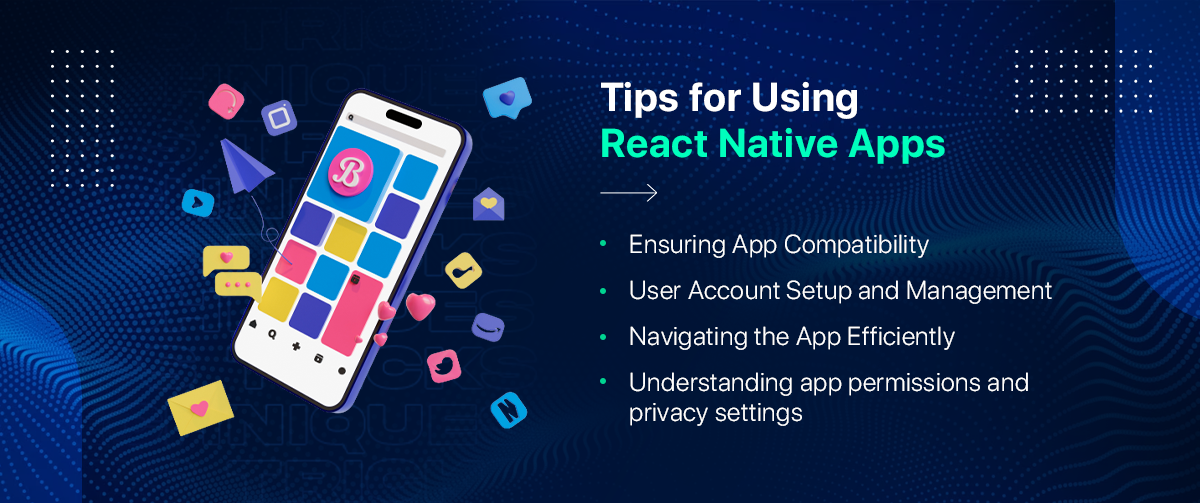
#1. Ensuring App Compatibility
1) Compatible Devices and Operating Systems
The first tip is to ensure your app is highly compatible. Ask developers to build an app that is highly compatible with all devices and operating systems. For example, if you are developing an Android app, ensure it offers users a uniform experience across all Android devices.
2) Keeping the App Updated
Another tip is to keep the app updated with the latest version. Keep adding new features and functionalities based on user feedback and the latest trends. It will improve user engagement and download numbers.
#2. User Account Setup and Management
The first thing your users interact with in your app is account setup. The tip here is to create a simple user account setup that users can finish within a few seconds. Using social media credentials can make things simple for users. In addition to that, make sure that user account management is headache-free and straightforward.
#3. Navigating the App Efficiently
Poor navigation makes the whole user experience terrible. You should avoid making a journey miserable for your users. An app with smooth and linear navigation helps users find what they want. Invest in good navigation, and you will get the best outcomes.
#4. Understanding App Permissions and Privacy Settings
You have to explain to your users about app permissions and how they will store the data shared by them. Data privacy is one of the most pertaining concerns among businesses. Ensure you adhere to all the guidelines and regulations while developing the app.
Tricks for a Seamless User Experience
User experience will determine the fate of your app. You should leave no stone unturned to ensure a seamless user experience. Here are some React Native tips for developers.
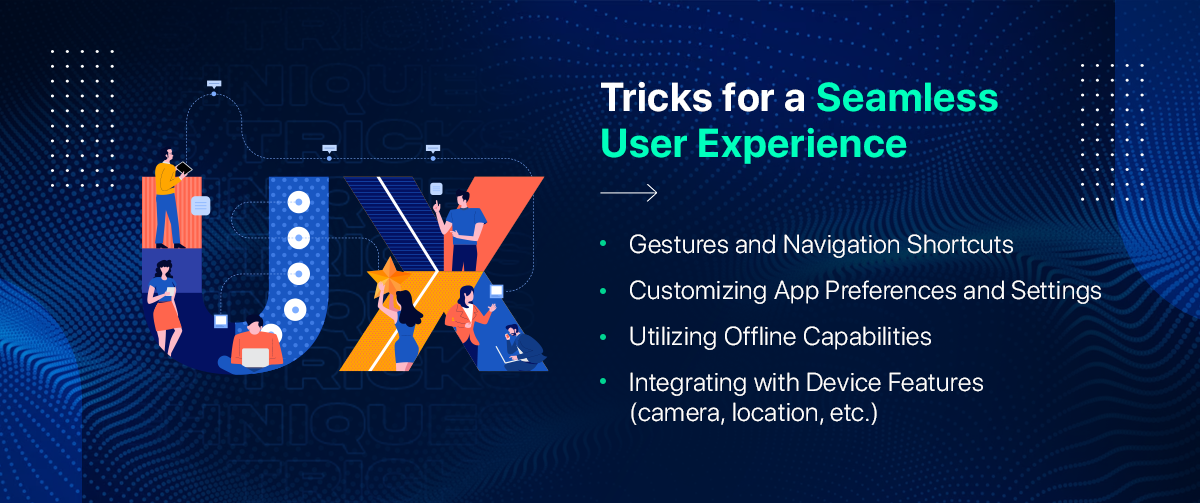
#1. Gestures and Navigation Shortcuts
You can use Gestures and navigation shortcuts to improve the overall user experience. In React Native, you can have a library called Gesture Handler. The main aim behind developing this library is to address the performance limitations of React Native’s Gesture Responder System. Furthermore, this library also offers better control to developers to use built-in native components for handling gestures.
Similarly, there are various navigation shortcuts available with React Native. Developers can use them to improve user experience.
#2. Customizing App Preferences and Settings
Customization is the key to winning the loyalty of your users. Give them customization options, and half the battle is won. Even users will love it when they customize the app as per their wishes.
#3. Utilizing Offline Capabilities
Unlike native apps, some features of cross-platform apps still work when the device is not connected to the internet. These offline capabilities of the app are crucial for users as they want to use some features offline.
#4. Integrating with Device Features (camera, location, etc.)
Integrating device features with your React Native app will give more control to users. It will also improve the overall experience. You can easily integrate native device features like camera, location, etc. into the app with simple commands.
Techniques for Troubleshooting and Support
Troubleshooting is also crucial when you come across any issues while developing an app. Here is a list of techniques for React Native troubleshooting and support.
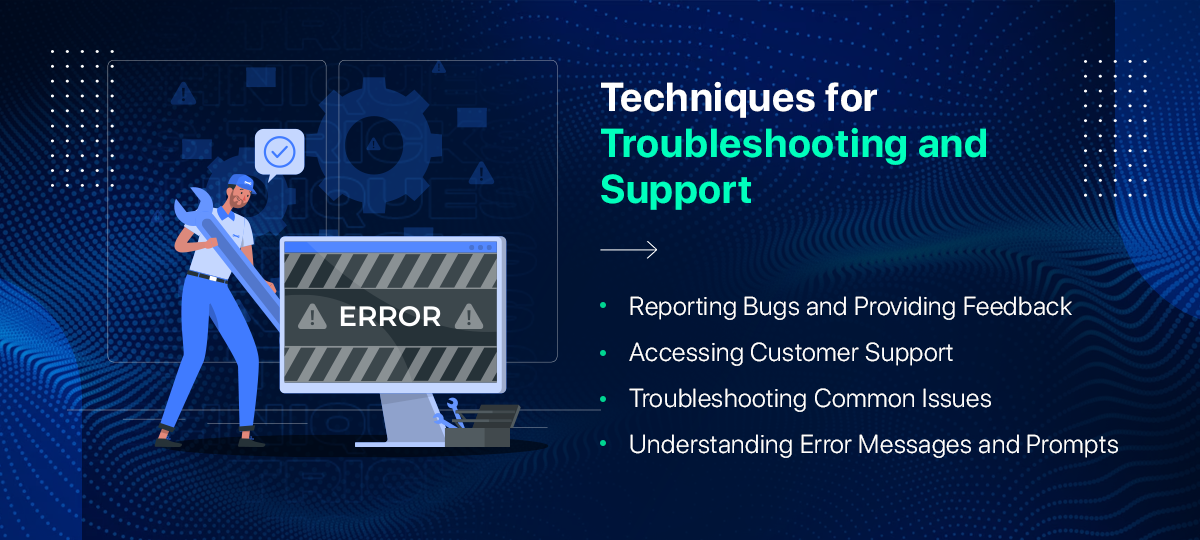
#1. Reporting Bugs and Providing Feedback
Users should be able to report bugs easily, if possible, with a single click. Also, you need to design the app in a manner that users can openly submit their feedback about the app and its functionalities. It will help you design the app or add features as per the user requirements.
#2. Accessing Customer Support
If users want to discuss something important, you need to offer them handy customer support. Millennials don’t like to wait. Remember that they should be able to contact your representative instantly when they are confused and need some guidance.
#3. Troubleshooting Common Issues
If there are some basic issues, you can guide users to troubleshoot independently. However, you must explain how to go for React Native troubleshooting through videos or tutorials.
#4. Understanding Error Messages and Prompts
Most technical error messages are written in a way that it would be impossible for a layman to understand. It will disinterest them instantly. Instead, write down and explain error messages with simple, flawless language to make them understand what went wrong.
User Interface (UI) Design for Ease of Use
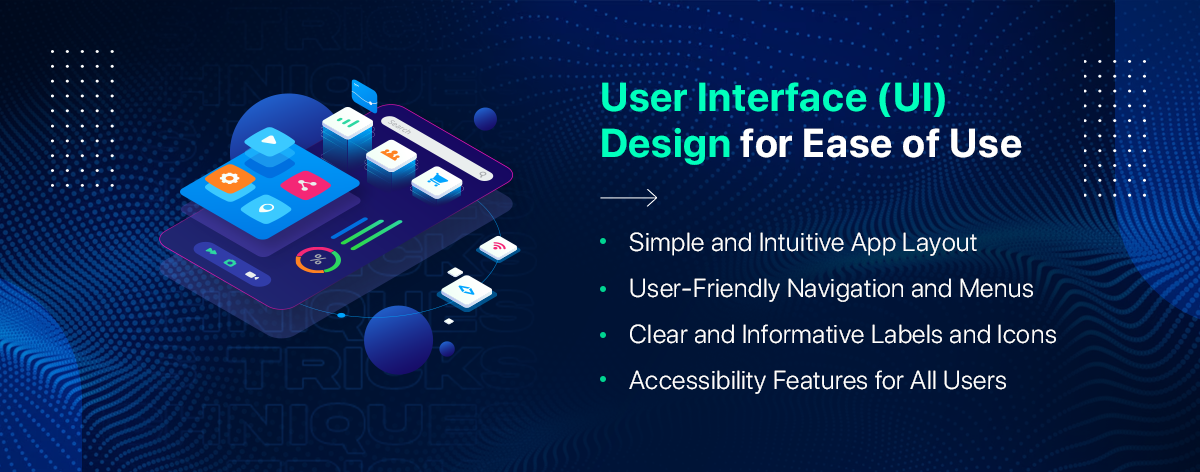
#1. Simple and Intuitive App Layout
A simple and highly intuitive app layout is a must to engage your users. Ask UI/UX designers to develop a simple, impressive, and highly immersive layout to make things easy for users.
#2. User-Friendly Navigation and Menus
Menus and navigation should be designed in a manner that users don’t have to work hard to find what they want. Don’t go stylish here! Just keep it simple.
#3. Clear and Informative Labels and Icons
Keep labels and icons simple, clean, and informative. They should clearly define the functions.
#4. Accessibility Features for All Users
Make sure that you keep all features accessible to users. They should be able to access and use all the features as and when they want.
Ensuring App Security
Security is a serious concern and must be dealt with with immense care. Here is a list of React Native tips and security practices while developing an app.
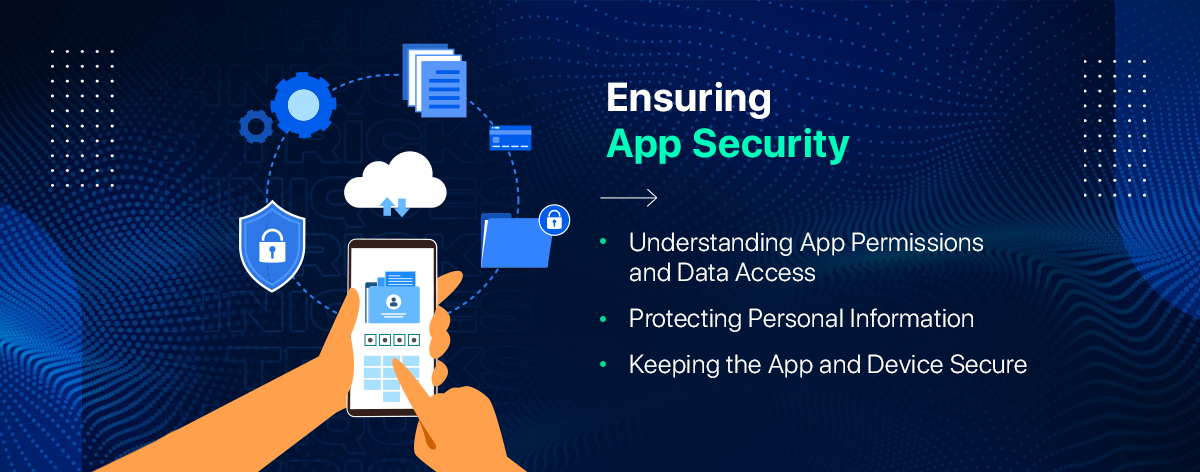
#1. Understanding App Permissions and Data Access
The app should educate users about all the required permissions and how they are given them. Also, you should discuss data access and use with users in detail.
#2. Protecting Personal Information
Data security is a primary concern. You need to protect the personal information shared by users and take all the precautionary measures to protect it.
#3. Keeping the App and Device Secure
Also, while developing a React Native app, you need to ensure that the app does not compromise the security of users' devices.
Staying Updated with App Features
Keeping your users updated with the newly added features is an essential thing to keep in mind. This is the last section of the React Native tips, tricks, and techniques.
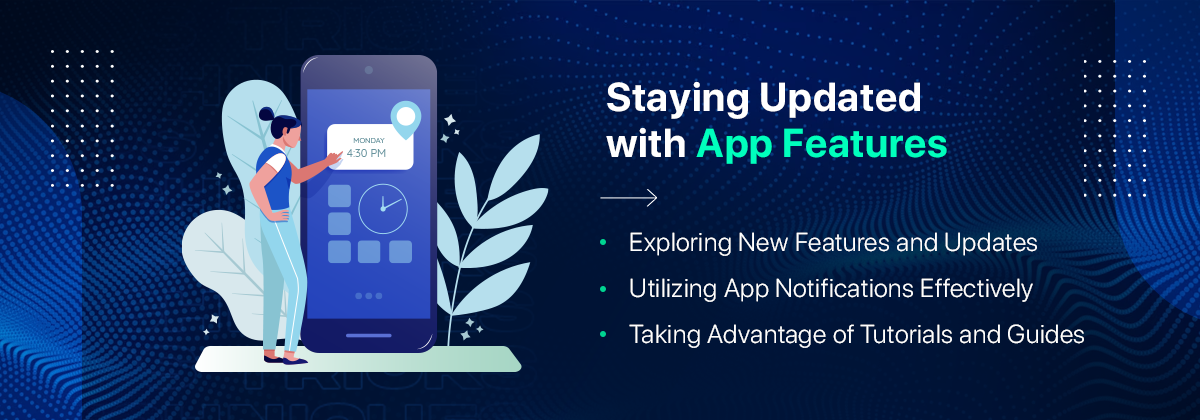
#1. Exploring New Features and Updates
Inform and encourage your users to use newly added features, functionalities, and updates to maximize user engagement. Also, encourage them to write their feedback about new updates and features to make data-driven decisions in the future.
#2. Utilizing App Notifications Effectively
You can easily use push notifications to inform your users about the latest features of the new app version. They will surely check them out to find out what is new and exciting about it. However, don’t send too many notifications as they might not like it.
#3. Taking Advantage of Tutorials and Guides
You can add various audio, video, or text tutorials and guides to educate users about the new features and functionalities in detail. You can upload such tutorials within the app and inform users through push notifications.
Conclusion
React Native is one of the most promising cross-platform app development frameworks that has set a benchmark. With these React Native tips, you can come up with an intuitive, feature-rich, and user-friendly mobile app for Android and iOS. Keep these tricks, tips, and techniques in mind while developing an app, and you will hit the jackpot.
Expert App Devs is a leading mobile app development company that offers dedicated React Native developers with sheer proficiency in the domain. Hire them to build a high-performance, robust, and intuitive cross-platform app.
 Jignen Pandya
Jignen Pandya







